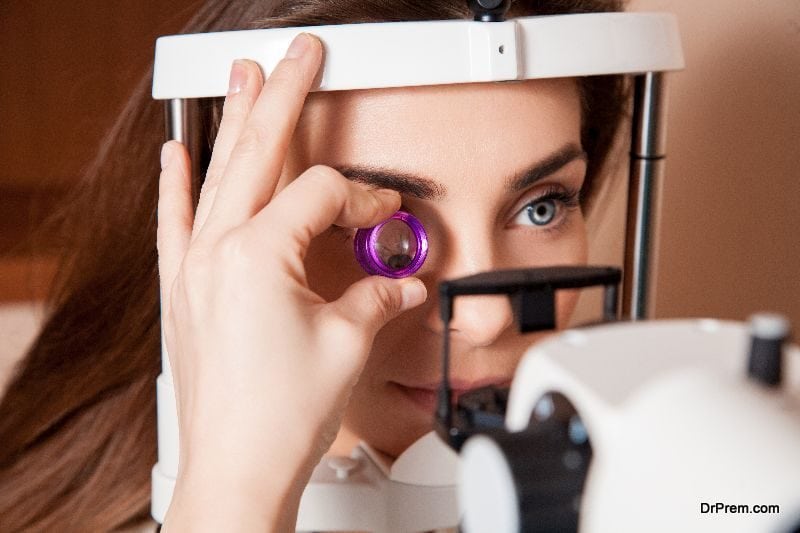There are over 250 million people living with compromised eyesight. That means millions of people struggling to read, drive a car or clearly see the face of their loved ones. This can be extremely disheartening and drastically impact their everyday life. But loss of your eyesight or a compromised condition can occur for many reasons. Some are related to age, while other are hereditary or due to injury. This article will discuss many different eye disorders, diseases and, conditions that may lead to loss of eyesight and treatment options.
Color Blindness

Color blindness is a hereditary condition and is much more common in men than women. This is because the condition is passed down through the X chromosome. When someone suffers from color blindness, it affects their ability to see reds, greens, and blues. It’s interesting to note that although color blindness primarily affects men, it’s often passed on through the mother who is a carrier but not a sufferer. In rare instances, color blindness is a side effect of another, pre-existing condition that goes untreated. These include diabetes, multiple sclerosis, and other eye conditions.
The severity of color blindness can vary from mild to moderate or severe. If you’ve inherited the condition, it will remain the same throughout your lifetime. This means it won’t get any worse or better. Other forms of color blindness can potentially worsen with time. Color blindness originates in the retina of the eye. Your retina contains light sensitive cells, or cones. How these cones react to certain colors determines how you view colors. A deficiency in one or more of these cones is what causes color blindness.
The symptoms of color blindness are pretty obvious and include an inability to distinguish between two colors or between different shades of the same color. Unfortunately, there is no cure for color blindness. Most people can see perfectly fine, despite the inability to differentiate colors. There are some contact lenses and regular lenses available with filters to help sufferers distinguish colors better but none that can restore sight completely.
Diabetic Macular Edema (DME)
The macula is located in the retina and is the portion of the eye responsible for detailed vision. Diabetic macular edema occurs when leaking blood vessels create an accumulation of fluid in the macula. Only individuals suffering from diabetic retinopathy can suffer from macular edema. Diabetic retinopathy is a condition which damages the blood vessels in the retina, causing impaired vision. If this condition is left untreated, the blood vessels build pressure and begin to leak, causing DME.
DME can occur in two forms – focal and diffuse. Focal DME means there are abnormalities in the eye’s blood vessel, whereas diffuse DME occurs due to the swelling of thin blood vessels known as retinal capillaries. Symptoms of DME include double vision, blurred vision, floaters, and eventually blindness.
The good news about treating diabetic macular edema is that there are treatment options available. Laser treatment is the most common treatment for DME. Laser procedures for DME focus on stopping the blood vessels from leaking. The operation itself is rather simple but the recovery process can be quite lengthy, ranging from 4 to 6 months. The healing process includes sensitivity to light, black spots, and irritation. This is due to swelling in and around the macula. Although you can’t always prevent the onset of DME, treating your diabetes and maintaining a healthy lifestyle can help. This means regularly exercising, eating a healthy, well-balanced diet, and scheduling regular check-ups with your eye doctor.
Retinal Detachment
 This is one eye condition where treatment cannot wait. Retinal detachment is an emergency situation where the eye’s retina pulls away from its normal position. This is a dangerous condition because the detachment means less oxygen and nourishment getting to the retina and the rest of the eye. If this condition goes untreated, patients are at risk for permanent vision loss. Retinal detachment is painless and if you recognize and treat the warning signs early on, you can reduce the risk of vision loss. The warning signs are unmistakable and include floaters, flashes of light and reduced vision. These symptoms may surface unexpectedly and without warning. If so, call your eye doctor immediately.
This is one eye condition where treatment cannot wait. Retinal detachment is an emergency situation where the eye’s retina pulls away from its normal position. This is a dangerous condition because the detachment means less oxygen and nourishment getting to the retina and the rest of the eye. If this condition goes untreated, patients are at risk for permanent vision loss. Retinal detachment is painless and if you recognize and treat the warning signs early on, you can reduce the risk of vision loss. The warning signs are unmistakable and include floaters, flashes of light and reduced vision. These symptoms may surface unexpectedly and without warning. If so, call your eye doctor immediately.
There are certain groups of people at greater risk for retinal detachment including individuals over the age 50, those who are nearsighted, and those with relatives who have experienced detached retinas. Other external factors can also cause retinal detachment. These include diabetes, injury, previous eye surgeries or sagging of the gel-like material that fills the inside of your eye. An optomologist will determine whether or not your retina is detached and the extent of your condition. Most situations require emergency surgery. The surgery to correct retinal detachment is minimally invasive. The most popular method is to inject a gas bubble into the eye. This presses the detached retina into place. A laser is then used to reattach the retina. Recovery is relatively easy but can take as long as 2 to 4 weeks for the doctor to clear you for regular activity.
Cataracts
Cataracts is a very common condition that causes blurred, cloudy vision in the normally clear lens of the human eye. This condition effects more than 22 million people over the age of 40. There are actually 3 forms of cataracts and each affect patients differently – subcapsular, nuclear, and cortical. Subcapsular cataracts effects the back of a person’s lens. Nuclear cataracts form in the nucleus or center of the lens and cortical cataracts start in the periphery of the eye, near the white portion, and work their way toward the center of the eye over time.
The onset of cataracts is slow. At first, you may not even notice the symptoms but over time, they will interfere with your vision. Here are several cataract symptoms that you may notice worsening over time:
- Needing brighter light for reading and seeing things
- Double vision in one eye
- Cloudy or blurred vision
- Sensitivity to light
- Difficulty seeing clearly at night
- Frequent need for new glasses or contact lenses
- Fading of colors
Once you notice these symptoms worsening or interfering with daily activities, it’s time to schedule an appointment with your doctor.
Cataracts are usually a result of aging or an injury to the tissue of your eye’s lens. Other external factors can cause cataracts to develop including long-term diabetes, previous eye surgeries or the use of steroid medications. So, what exactly happens to your eye during cataracts? Your eyes lens is flexible and transparent but as you age, the lens becomes thicker and the tissues of the lens may break down or clump together, creating cloudiness and trouble seeing clearly. As this condition worsens, the burry appearance becomes more widespread and covers a larger part of the lens. Cataracts generally develop in both eyes but could be more severe in one than the other. Certain underlying conditions can also put you at greater risk for developing cataracts. These include:
- Obesity
- Diabetes
- High blood pressure
- Excessive alcohol consumption
- Smoking
- Over exposure to sunlight
- Age
The most common treatment for cataracts is surgery, which is a relatively simple, painless procedure. During cataracts surgery, the defective eye lens is removed and replaced with an artificial one. The old, damaged lens is generally removed using a laser or ultrasound energy. The procedure is done in an outpatient facility and the recovery is minimal, though every patient is different. Your doctor will give you a list of instructions and restrictions following your surgery. Read more about those here. In terms of preventative methods, you can help reduce your risk of developing cataracts by scheduling routine eye exams, minimizing your exposure to alcohol and smoking, and following a healthy diet and exercise plan.
Glaucoma
 Glaucoma isn’t one specific eye disorder, but instead a group of eye conditions that, over time, causes blindness. The diseases that cause glaucoma attack the eye’s optic nerve, which connects the retina to the brain and is responsible for clear vision. The main cause of glaucoma and damage to the optic nerve is pressure. Glaucoma is a hereditary condition and one that doesn’t present itself into much later in life.
Glaucoma isn’t one specific eye disorder, but instead a group of eye conditions that, over time, causes blindness. The diseases that cause glaucoma attack the eye’s optic nerve, which connects the retina to the brain and is responsible for clear vision. The main cause of glaucoma and damage to the optic nerve is pressure. Glaucoma is a hereditary condition and one that doesn’t present itself into much later in life.
It’s not easy to prevent glaucoma because there are no real onset symptoms of the diseases. Generally, routine visits to your ophthalmologist is the best way to determine if you have the condition and begin a treatment plan. There are two typs of glaucoma – open-angle and angle-closure. Open-angle glaucoma is the most common and means that the fluids in your eye are not flowing properly. Angle-closure glaucoma is somewhat rare and occurs when the fluid in your eye doesn’t drain properly due to a narrowed space between the cornea and iris.
Risk factors for glaucoma include your hereditary background (African-American, Irish, Scandinavian, Hispanic, Russian, and Japanese are at higher risk), anyone over the age of 40, diabetes, poor vision, and a family history of the disease. Although symptoms are minimal and not often severe enough to cause immediate concern, they include loss of peripheral vision, headaches, sudden eye pain, and halos around light. Once it’s determined that you have glaucoma, treatment options include prescription eye drops or different types of laser eye surgery. There is no way to prevent glaucoma but diagnosing it early can help reduce your risk of permanent vision loss.
The best way to prevent and diagnose these common eye disorders is to schedule regular appointments with your eye doctor and be aware of potential symptoms. If you experience a sudden change in your vision, it’s best to call your doctor immediately so they can determine the cause and rectify it quickly.
Article Submitted By Community Writer




